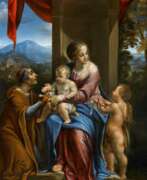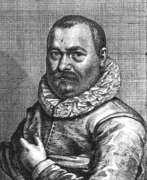Animalists 16th century


Abraham Bloemaert was a Dutch painter, draughtsman, and printmaker from the Golden Age of Dutch painting, one of the founders of the Guild of St. Luke in Utrecht. Bloemart was a caravagist. He painted mainly landscapes, mythological and biblical scenes, and pastoral works.


Angelo Caroselli was an Italian painter, born and active during the Baroque period, primarily in Rome. Known for his eclectic style, Caroselli's work was significantly influenced by Caravaggio, evident in the naturalism and chiaroscuro that marked his compositions. His subject matter often included colorful characters from contemporary Rome, scenes of witchcraft, musicians, and genre scenes reflective of the Caravaggisti, a group of artists who followed Caravaggio's stylistic approach. Caroselli's ability to blend allegories, religious works, and portraits with genre scenes showcased his search for originality and a unique narrative voice within the Baroque movement.
Angelo Caroselli's career was marked by his versatility as not only a painter but also an art restorer, copyist, and possibly a forger. This breadth of skills contributed to the diverse body of work he left behind, which ranged from scenes of everyday life to complex allegorical compositions. His works often depicted the lower echelons of society, including musicians, card players, and prostitutes, infused with a potent naturalism that brought these figures to life against the backdrop of 17th-century Rome.
Despite his adherence to Caravaggesque forms and themes, Angelo Caroselli's work also displayed 'archaicising' elements, which some art historians view as a conscious departure from the dominant Baroque style of his time. This aspect of his work, along with his skill in copying the works of ancient masters, highlights a deliberate exploration of and departure from the prevailing artistic norms, contributing to the unique place he occupies in Baroque art history.
Notably, Caroselli's influence extended beyond Italy, affecting the work of other Caravaggisti, including the Lucchese painter Pietro Paolini and the Dutch painter Dirck van Baburen. This cross-cultural impact underscores the broader significance of Caroselli's work within the Baroque period and its enduring influence on subsequent generations of artists.
His legacy includes several known works that are housed in prestigious institutions and collections worldwide, exemplifying the enduring appeal and historical importance of his artistic contributions. Among these, "The Plague at Ashdod (after Poussin)" stands out as a significant piece, reflecting his capability to engage with and reinterpret the works of his contemporaries and predecessors.
For collectors and experts in art and antiques, Caroselli's oeuvre offers a fascinating glimpse into the Baroque period's complexity, characterized by a blend of innovation, tradition, and a deep engagement with the human condition. His work remains a testament to the vibrancy and dynamism of 17th-century Italian art, inviting ongoing exploration and appreciation.
To stay updated on new discoveries, sales, and auction events related to Angelo Caroselli, sign up for our newsletter. This subscription ensures you're the first to know about the latest findings and opportunities to acquire works by or related to Angelo Caroselli, catering specifically to enthusiasts and collectors of historical art and antiques.


Giovanni Battista Castello was an Italian historical painter. His best-known works are the paintings on the vault of the Basilica della Santissima Annunziata del Vastato. He was an architect and sculptor as well as painter. He painted of the Martyrdom of St. Sebastian in the monastery of San Sebastiano. He worked on various projects with his friend Cambiaso, including in a chapel for the Duomo di San Lorenzo.


Roelant Savery was a Flanders-born Dutch Golden Age painter.
Savery primarily painted landscapes in the Flemish tradition of Gillis van Coninxloo, often embellished with many meticulously painted animals and plants, regularly with a mythological or biblical theme as background. He also painted multiple flower still lifes; bouquets in stone niches, sometimes with lizards such as Flowers with Two Lizards, insects or fallen petals and regarded as his best work.
His unique style of painting, related to the then reigning Mannerism, has been highly popular with collectors and can be found in many museums in Europe and North America. His preparatory drawings are also valued highly.


Lazzaro Tavarone was an Italian painter of the late-Renaissance and Mannerist period, active mainly in his native Genoa and in Spain. He was the pupil of the painter Luca Cambiasi. Tavarone accompanied Cambiaso to Spain in 1583, and helped decorate the Escorial for the Spanish King, including the chaotic battle painting of Battle of La Higueruela. He returned to Genoa in 1594, where he became well known both as portrait and history painter.





